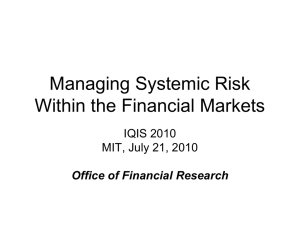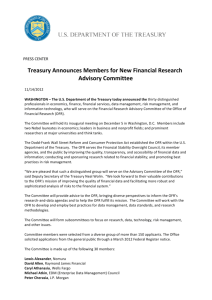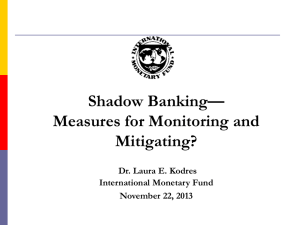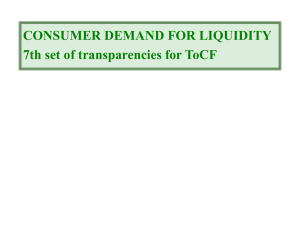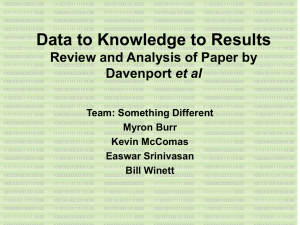Systemic Risk and Big Data
advertisement
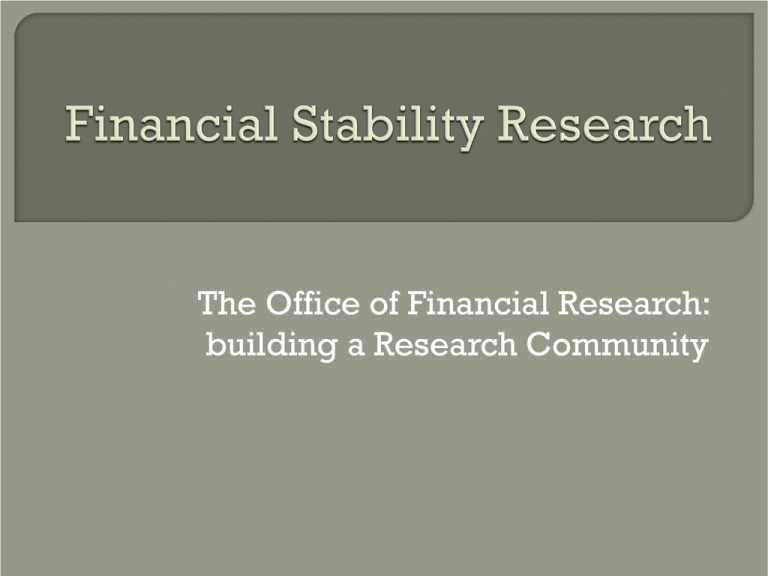
The Office of Financial Research: building a Research Community Did they know what was going on? Did they know what was going on? Did they have a choice? “If this crisis has taught us anything, it has taught us that risk to our system can come from almost any quarter. We must be able to look in every corner and across the horizon for dangers and our system was not able to do that.” Secretary Geithner, opening remarks, testimony to Senate Banking Committee, June 18, 2009. Sen. Jack Reed, adequacy of data and risk analysis systems for system-wide risks We have good starting points, with regards to models; we need better data, not clear what data. This will require a new approach to finance/economics research: • Large Science approach – large scale, multidisciplinary teams • Long-term sustained research effort that will iterate between better models and need for better or more refined data. Loss Distribution • Tail events are rare – very little data • Typically strong model assumptions Loss Distribution • Tail events are rare – very little data • Typically strong model assumptions • Liquidity Failures Can’t hedge No replicating portfolios Mean & Variance Game Theory We are not in Kansas anymore Loss Distribution • Tail events are rare – very little data • Typically strong model assumptions • Liquidity Failures • Scenario Analysis Linkages – rights, obligations (Not Netting!) Granular Macro Economics Understanding Domino Risk Loss Distribution • Tail events are rare – very little data • Typically strong model assumptions • Liquidity Failures • Scenario Analysis • Economic Impact CaR – Credit at Risk DoL – Distribution of Loss Monitoring health of Economy Regime shifting models Summaries reflecting stress Historical data Derivatives data Looking for Black Swans Leverage measures Concentrations, Bubbles Liquidity capacity Linkages and Transparency Not predicting cascading failures Determine loss by counterparty Do not predict probability of failure of counterparties Do not account for Linkages Proposed Part by concerned citizens of regulatory reform legislation Collect system-wide transaction data Develop analytic tools Did they know what was going on? Did they have a choice? Can we afford to have this happen again? Office of the Comptroller of the Currency workshop, Feb. 2009 • Proposed National Institute of Finance (NIF) • Collect system-wide data, build analytic tools and monitor systemic-risk Committee to Establish a NIF • Broad collection of concerned citizens • Legislative Response – OFR is now law Office of Financial Research works for the Financial Stability Oversight Council • Better data and analysis tools • Long-term research • Regulatory Commons • Independent voice Two components • Data Center • Research and Analysis Center Dodd Frank Act is law Treasury Key sets up initial OFR Initiatives • Reference data (Treasury’s current focus) • Common computing and data infrastructure • Build initial risk monitoring system • Key long-term research efforts • Investigate past crisis Organize a Penn State Initiative • Key long-term research efforts Conceptual models and mathematical models Identifying important areas of collaboration Seminar Series/Workshops University Center, NSF Funding? Potential Benefits • Future Funding • Back-up data center Broader Initiatives (Other Universities and Industry partners) Initial analytic systemic risk systems Competitive Frameworks for comparison of systemic risk systems Testing scenarios to prove how different technologies could apply Cross-over of technologies that can be used for systemic risk Maps of the financial system Demonstration of prototypes and feasibility studies International Collaboration on Data • Common reporting requirements in key markets for market participants • OFR standards offer a point for building common standards International Collaboration on Research • International body help coordinate and facilitate research across countries, in the public interest
